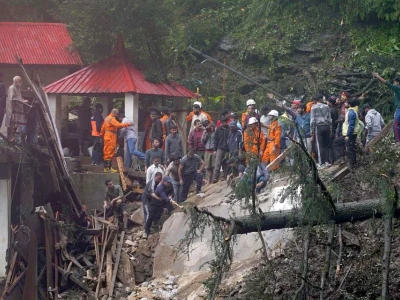
Deadly floods engulf parts of South Asia as extreme weather devastates vulnerable region
Studies have shown monsoons are becoming more erratic due to the climate crisis, posing significant risks to critical sectors such as agriculture and water.
From Afghanistan to Bangladesh, India to Nepal, flash flooding and torrential rain have killed hundreds of people in recent weeks, as the climate crisis amplifies the effects of the monsoon season, bringing widespread devastation to South Asia.
Millions of people have been displaced by floods, landslides and heavy rains in recent weeks across the region, which is home to about a quarter of the world’s population and among the most vulnerable to the impacts of the human-caused climate crisis.
Flooding from annual monsoon rains is common in South Asia but the climate crisis has turbocharged extreme weather events across the region, scientists say, with prolonged and intense heat waves giving way to record rainfall and storms.
At least 40 people were killed and 347 injured in flooding from heavy rains in eastern Afghanistan, the health ministry said on Tuesday. In India, 97 people have died in flooding in northeast Assam state since May, official figures showed. Large-scale floods in northeast Bangladesh have impacted more than 2 million people. And flash floods and landslides in Nepal have killed dozens, according to the NGO Nepal Centre for Disaster Management (NCDM).
The prolonged downpours have swollen rivers to beyond danger levels, critical infrastructure has been damaged, roads have been inundated and homes and crops destroyed across South Asia.
In Afghanistan, storms have destroyed many homes, the health ministry said Tuesday, leaving displaced residents without access to basic necessities. About 1,500 children have lost their homes, according to Save the Children.
The children’s organization said the storms damaged a reception center in Torkham, which was set up to support some of the 650,000 Afghans who have returned to the country since September 2023, after being forced out of Pakistan in a crackdown on migrants.
Bridges and roads have also been destroyed by the floods, according to the International Rescue Committee, which said it has deployed emergency health and response teams to the worst affected areas in Nangarhar province to help the injured and those cut off by the storms.
“The continuation of climate-induced disasters in Afghanistan ought to be cause for grave concern,” said IRC Afghanistan director Salma ben Aissa in a statement. “Decades of conflict and economic crisis has meant that the country has faced setback after setback as it tries to find its feet. The sad reality is that without a massive increase in support from donors and the international community, many more will lose their lives.”
Region under threat
The floods come just two months after major flooding and rainfall in northeast Afghanistan killed more than 300 people and destroyed over 1,000 homes, according to the Word Food Programme.
In Nepal, at least 115 people have been killed and tens of thousands displaced since May as record rainfall and flash floods inundated parts of the Himalayan country.
Last week, a landslide swept away two buses carrying 65 people, prompting a huge search operation to locate 55 missing people in Chitwan, about 86 kilometers (53 miles) west of the capital Kathmandu, Reuters reported.
“It is predicted that over 2 million people across 400,000 households will be impacted by flooding this monsoon season as Nepal is expected to receive above average rainfall and it is only the beginning of the season,” Bishal Nath Upreti, NCDM president told CNN Wednesday.
Heavy rains and floods have also hit much of India’s northeast, east and northwest coast and followed weeks of blistering heat, with one part of Delhi reaching 49.9 degrees Celsius (121.8 degrees Fahrenheit) in late May — the capital’s highest temperature on record.
In flood-hit Assam, more than 1,000 villages across half of the state had been hit by floods and 15,000 people have sought shelter in relief camps as of Tuesday, the Assam State Disaster Management Authority said.
In Assam’s Kaziranga National Park, at least 213 animals, including 12 rhinos, have been killed in flooding, a government bulletin said Wednesday.
Since June, more than 2 million people have been impacted by flooding in Bangladesh’s northeast, including 772,000 children, according to state media and humanitarian agencies. The mass displacement caused by prolonged rain and widespread floods has raised concerns of malnutrition and deadly waterborne diseases, particularly in children.
International development organization BRAC said flooding in the country is “becoming more dangerous” with “huge losses to livelihoods, biodiversity and infrastructure — and interruption to schooling and health services.”
The seasonal monsoon rains are vital for quenching fields, nourishing crops, and replenishing reservoirs. But studies have shown monsoons are becoming more erratic due to the climate crisis, posing significant risks to critical sectors such as agriculture, water, and energy.
The extreme weather and flooding across South Asia have renewed calls for immediate climate action and put added focus on how vulnerable people who have least contributed to rising global temperatures are being hit hard by the climate crisis.
“The large economic disparities in the South Asia region have only magnified the sufferings of the most vulnerable and marginalized communities, with a large death toll and displacement figure year on year,” said Marta Schaaf, program director for climate, economic social justice and corporate accountability at Amnesty International, in a statement Monday.
“These communities contributed almost nothing to greenhouse gas emissions, yet they are paying for government inaction on climate with their livelihoods and all too often – their lives. There can be no solution without a roadmap for climate justice and there is no climate justice without human rights.”




